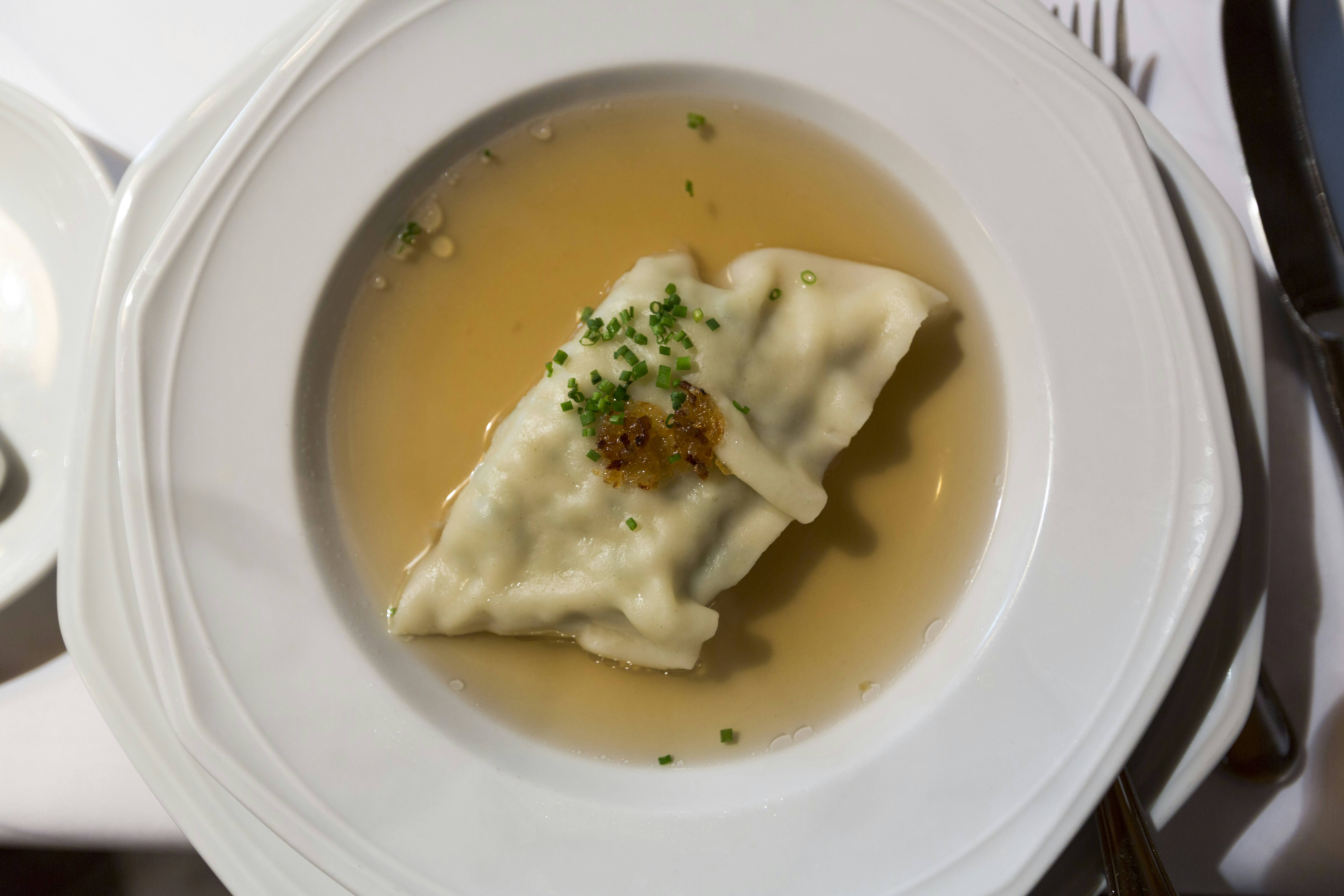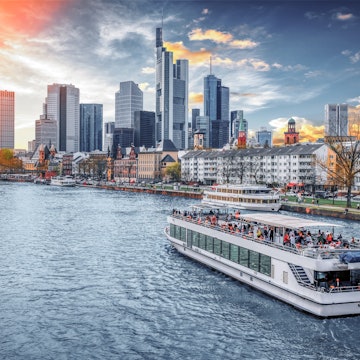
Wine on the Rhine: three German wine regions off the beaten path
Oct 7, 2019 • 7 min read

Rolling vineyards surrounded Staufenberg Castle near Durbach, Germany in the Baden-Württemberg wine region. Marco Bottigelli / Getty Images
Perched above a fairytale village where flowers bulge over every windowsill, hedges are neatly trimmed, and colorful shutters line the streets are vineyards blanketing such an angular slope that one wrong step could topple you down the grape-strewn hillside. It could be a scene out of "Hansel and Gretel" or Heidi. Instead, I’m in the heart of German wine country where – contrary to popular belief – Riesling is far from the only grape on offer.
Here in the southwestern wine growing region of Baden, I’m sipping a glass of light ruby red Spätburgunder – Germany’s pinot noir. Just within the last twenty years, this luscious red has climbed in popularity, and now not only makes up over a third of Germany’s wine sales, but has established Germany as the third-largest pinot noir producer in the world, behind France and the United States.

That shift is thanks to both domestic demand for pinot and the vagaries of climate change. Shifting weather patterns now allow a slew of grape varieties to grow where they once couldn’t, and as a result roses and dry sparkling wines can easily be found amongst 135 different grape varietals that grow throughout 13 German wine regions. Each of those regions are dotted with charming medieval villages, countless estates and castles, and are certainly not to be missed.
Don’t expect gimmicky, commercialized wineries selling souvenirs, either. Germany’s rustic wineries in Baden and beyond tend to not charge a fee for a tasting, and while it’s often expected that you buy a bottle, most cost around just 8-10 euros, you may find yourself stuffing your suitcase with the spoils of each tasting. If you aren’t sure where to begin, however, start with these 3 lesser-known regions where you can try wine on the Rhine and off the beaten path:
Baden wine country
Most of Baden’s vineyards are situated in a 250-mile stretch of land between the Black Forest and the Rhine. It’s a warm and sunny wine region comparable in climate to France’s Loire Valley. You can expect a wide range of grapes and styles due to the diversity of soil types and microclimates within Baden, not to mention the area’s centuries-old viticultural traditions.
Weingut Schloss Neuweier
From Frankfurt or Stuttgart head south towards Weingut Schloss Neuweier in Baden-Baden. The wine barrels at this vineyard come with names like Pura Vida and Eye of the Tiger, monikers meant to reflect the love put into each barrel. Here you’ll find Grand Cru wines dating back to the reign of Queen Victoria, sparkling wines, and even non-alcoholic grape ginger juice grown in view of the glorious Neuweier Castle.
Consider a stay at Hotel Hirschen in Lehen. It’s worth spending the night just to dine at Restaurant Hirschen, which serves dishes like beef cheek, lobster soup, wiener schnitzel, pillowy maultaschen (a ravioli-esque dish) with chanterelles, Black Forest ice cream dessert with tart cherries, all nicely paired with a Roséor Kirchberg Spätburgunder GG from Weingut Salway, grown in volcanic soil.
Weingut Ziereisen
At Weingut Ziereisen steep sloping vineyards grow atop Jurassic limestone, into which the winery’s cellar cave is dug. As jovial winemaker Hanspeter Ziereisen likes to exclaim, “Work dirty in the cellar with clean grapes.” That’s also the same cellar where guests are greeted by an overhead sound art installation created by German-born kinetic sculptor Trimpin. While you sip, munch on German-style focaccia bread brought to Baden by Italian railroad workers hundreds of years ago.
The bread isn’t the only part of Weingut Ziereisen with a long history. While the vines here are sixty years old, the Ziereisen family have been a part of the village of Efringen-Kirchen since 1734. As you tour the grounds, you can admire the engraved oak barrels from around this same period. Don’t expect riesling here, however. The Ziereisens experiment with syrah and grow plenty of pinot blanc and chardonnay, but their passionate local specialties are the spätburgunder and gutedel – an ancient white grape. The later wines mature up to 24 months in the barrel and another 9 months in the bottle.
Weingut Schneider
The two young brothers responsible for the luscious wines at Weingut Schneider, including that glittering red glass of spätburgunder, have had family ties to the area since 1492. Savor a complex pinot or gutedel before climbing up into the vineyards to watch a dynamic sunset over Switzerland and France. You can arrange for a jeep ride and picnic lunch amongst the vines near the vineyard’s elegant open-air cottage overlooking the town below.
Related content: Bavaria & Eastern Germany: why a food and wine tour is not the wurst idea
A wine tour of the Balkans
Weingut Bercher
No trip to German wine country is complete without getting lost in the picture-perfect colorful village of Burkheim. Meander vineyards that sit side by side with a ruined 13th century castle, and find your way to the Corkscrew Museum before arrange for a tasting at Weingut Bercher. Here, tenth generation winemakers share their 2016 pinot noir – one of the best vintages in decades. Don’t leave without a bottle of the 2017 Grauburgunder GG or the 2016 sweet Spätburgunder dessert wine, either.
Weingut Schloss Ortenberg
In the golden village of Durbach there are twelve wineries including Weingut Schloss Ortenberg, where the winemaker reminds visitors that “great varietals do not have a nationality.” Founded in 1500 and merged with a famous research estate, today you can sample wines a deck with admirable views of Vosges and Alsace. Due to global warming, this area now experiences cold nights and warm days that produce cabernets, merlots and syrahs – and even tempranillos. Nearby, stay overnight and dine at Hotel Zur Linde. The hotel’s restaurant with a garden terrace offers freshly prepared dishes with generous portions.
Württemberg
Red wine dominates this rural, hilly region adjacent to Baden - especially crisp, light trollinger, which is grown almost exclusively in Württemberg. Regional reds with more body include the schwarzriesling (Pinot Meunier), lemberger, and spätburgunder, while riesling is still the most important white variety. Most vineyards in Württemberg deliver their grapes to about fifty cooperatives which sell about 80% of all the region's wines.
Weingut Dautel
For 500 years, Christian Dautel’s family has been growing grapes at Weingut Dautel, where the young winemaker works intuitively with each site and varietal. Hugging the Ahr and Nekar Rivers, the nearly-vertical 70-degree slopes require sturdy workers and harvester machines, but the results are sparkling wines, steingrubens (Pinot Noir), and weissburgunders well worth savoring.

Bensheim
Experience a traditional lunch at Restaurant Alte Dorfmühle Auerbach in Bensheim, a short detour from Heidelberg, Manheim, or Frankfurt. Try schnitzel, pork steak, cooked cheese, and homemade sausage in this timbered cottage with wine bar and beer garden. Select a local wine from Weingut Hanno Rothweiler or Weingut Simon Bürkel for yet another taste of Württemberg.
Zum Hirschen is one of several Michelin star restaurants in the Fellbach area outside of Stuttgart. An extraordinary regional menu boasts beef tartar with truffles, assorted veggies with goat cheese, and maultaschen with chanterelles, well-paired with a 2018 Rose or a 2017 Simonroth Spätburgunder from Weingut Schnaitmann.
Pfalz
The Pfalz region is sunny and dry, with red and yellow variegated sandstone soils which grow exceptional rieslings. Vineyards bask in the milky-mild light while figs, almond blossoms, chestnuts, and even kiwis bloom. No wonder the Romans and their vines felt at home here thousands of years ago!
Weingut Klundt
Pfalz is the fastest-growing wine region in Germany and the second largest in acreage after Mosel. While it's flush with riesling, plenty of other white grapes flourish here, and reds are on the rise. Those trends are deliciously evident at Weingut Klundt, where ambitious young winemaker Sven Klundt is making and selling wine with sustainable practices. In this petite wine room, savor a traditional riesling, sparkling Extra Brut, or Pinot Noir Obsession.
Weingut Weegmüller
Since 1685, family-owned Weingut Weegmüller, run by two sisters, still operates in the Baroque facilities built in the 1730s in Haardt where white asparagus, grapes, almonds, walnuts, lemons and figs grow too. Sip premier juicy riesling, pinot gris (2016 Grauer Burgunder) or a 2017 Gewürztraminer while ambling through the vines and admiring dramatic hilltop castles.
“Good wine comes from the vineyard. You can have some influence in the cellar,” quips the winemaker manager at Wachtenburg Winzer eG, a co-op touting over a 100 wines in their modern tasting room. Shiny tanks and mass production don’t mean a hit in quality here. Rather, you can find an incredible selection of light, dry rieslings, rosés, dry sparkling wines, and pinot noirs at affordable prices.















